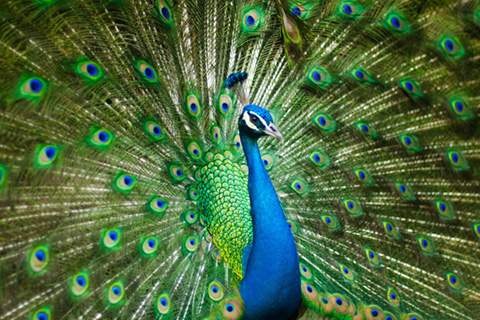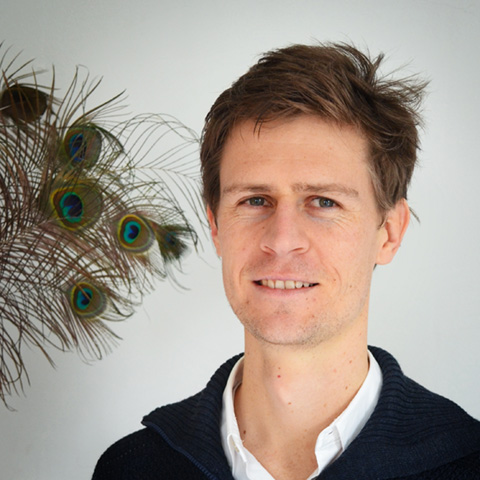
Pascal Freyer studies bird feathers
How the peacock gets its colours

The iridescent blue of peacock feathers is so iconic that it’s fascinated people for millennia, and physicist Pascal Freyer is no exception. Living in Namibia as a kid, he often encountered the red-shouldered glossy starling. He couldn’t keep his eyes off the bird. The gloss that makes this starling so special can be found all over the world: in the blue feathers on magpies in Europe, hummingbirds in America, and peacocks in Asia.
Freyer was unable to shake the fascination, and he was so determined to figure out where that brilliance came from, that he turned to an electron microscope, hoping to uncover the secrets of light and gloss. ‘I wanted to be inspired by nature, and learn from it’, says Freyer.
Pigment
The colouring in bird feathers differs greatly from that in mammals’ skins. Take cows, monkeys, foxes, or a more colourful animal like leopards, zebras, or giant pandas. They’re nice, but they pale in comparison to the brilliant blues and oranges of mandarin ducks, hummingbirds, or peacocks. ‘Most of the colours we see are created by the way pigment absorbs light’, Freyer explains. ‘These pigments can be found in animal tissue as microscopic particles.’
The gloss on feathers kind of works like a soap bubble
When white light, which contains the entire colour spectrum, hits a particular patch of pigment, this patch can absorb, for example, the blue light from that spectrum. ‘When that happens, we see the colour red’, says Freyer.
The most well-known pigment in people is melanin, which absorbs a lot of blue and UV light. Melanosomes protect the skin, visibly manifesting as moles.
Macro shots of a peacock feather
Thin layers
Birds have these same kinds of pigments, but they have another trick up their sleeves to create the bright, glossy colours of their feathers. ‘The difference lies in how they arrange their pigments’, says Freyer. ‘Peacock feathers, for example, contain certain structures that are very carefully laid out close together, only one or two hundred nanometres away from each other’, he explains. That’s a distance as thin as two thousandth of a human hair.
‘These structures consist of the same brown pigments that our moles do, but the light bounces in an out of it in such a way that it comes back out blue and shimmery rather than brown.’
You can’t create colours this bright using pigment
‘The gloss on feathers kind of works like a soap bubble: a thin layer of soap and water reflects the light in a focused manner’, says Freyer. The same thing happens in all those thin layers in a peacock feather. The shimmery rainbow effect is a colour created by the structure of the soap and water, since they don’t have any pigment. The light reflection in bird feathers is much more selective than that in a soap bubble, which is why we see only one colour. ‘The light waves bounce off each other, which can either weaken or strengthen them. This phenomenon is called interference, and birds use it to create perfect optical signals.’
Copy
If we can figure out exactly how birds do this, we might be able to copy it and use it for something else. ‘It would be a new way of creating colours, except we’d use the ancient “wisdom” of nature’, says Freyer. ‘You wouldn’t even be able to create colours this bright with pigment.’
Until recently, this kind of research wasn’t possible. Freyer used microscopes, cameras, computer models, and a lot of light-measuring equipment to reveal the secrets of peacock feathers’ colours. ‘Before, they needed to simplify their measurements just to be able to make calculations’, says Freyer. ‘Doing it by hand would take days. Now that we have computer models, it only takes a few seconds.’
Calculations used to take days to make
He adjusted the thickness and characteristics of these layers in his mathematical models. By playing with the various parameters, he eventually discovered new patterns in the way the light fragments in bird feathers. It’s not just the distance between the layers that plays a role; the amount of air in between is also important.
Freyer’s models will allow us to understand the colours of bird’s feathers, from ducks to magpies. The peacock feather turned out to be the most complex of them all, though. ‘Biologists think that the colour blue that we love so much is even more attractive to peahens, which is who this signal is meant for in the first place’, says Freyer. Just like peacocks, our eyes contain cones, which allow us to perceive colour. Certain wavelengths affect them more than others, just like in peacocks.
Computer chips
But we could use the technology behind these striking feathers for more than just aesthetics. Freyer’s discoveries could be used to make data transfer faster and more efficient, and they might even be used to improve computer chips. ‘The processors in computers are limited because they use electronic signals. Light is faster, so that might be a solution’, says Freyer. The physical phenomena that he has discovered might help with that.
Any kind of actual application won’t be possible for a long time, but Freyer doesn’t care. He’s driven by his curiosity for the world around him. He wants to understand it entirely. ‘The other day, I was reading an article by a couple of scientists in Nature, where they described the physics behind a drying coffee stain’, says Freyer. ‘Just for fun, because they were curious.’
He chuckles. ‘Like Feringa says: “Let universities be playgrounds.” Not every bit of research has to be justified and contextualised all the time.’